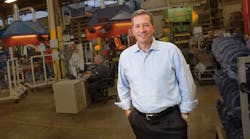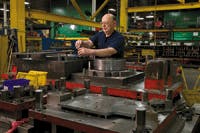Legendary lean practitioner Art Byrne says he didn't have to accept excuses from employees when he requested dramatic improvements on the plant floor. That's because Byrne had become a "lean expert" and knew what type of changes were possible.
"The CEO has to be comfortable making other people uncomfortable in order to get big change," says the former Wiremold Co. CEO. "That's part of the reason you want to be a lean expert."
Byrne, who now serves as operating partner at private equity firm J.W. Childs Associates, helped turn around wiring and cable products manufacturer Wiremold in the 1990s using lean as the foundation. He recalls a situation at Wiremold, since acquired by France's Legrand SA, in which he challenged plant-floor workers to cut a machine setup time from 14 hours to less than 10 minutes.
See Also: Lean Manufacturing Leadership Best Practices
Initially, employees told Byrne it wasn't possible and thought he was "nuts," Byrne says. But after several kaizens and machine alterations, the plant reduced setup time for the large rolling mill to six minutes. A CEO less knowledgeable about lean may have accepted the employees' initial response, and no changes would have occurred, Byrne says.
An Ariens tool and die employee works on a die. Lean manufacturing helped the company move from a batch-driven environment to continuous flow.
The CEO's role in lean management hasn't always been as active as Byrne describes. Such a lack of direct involvement means many manufacturers are not realizing the full benefits of lean. Most CEOs are simply delegating responsibility down the workforce ladder to accomplish lean results, says Jake Stiles, president and co-partner of lean executive search firm Stiles Associates. These CEOs often view lean as a tool rather than a business philosophy.
Focusing on tools, such as the 5S organization method, will produce limited results because the company culture still has not changed, says lean consultant Mike Micklewright, president of process improvement consulting firm Quality Quest Inc. While a CEO doesn't always have to be directly involved in lean activities, such as kaizen events, the company's top executive should be visible in the lean process and continually asking questions, he says.
"If you manage [lean] from the boardroom or the conference room, you don't get the full picture," Micklewright explains. CEOs should serve as a lean coach or mentor to key staff members, not only empowering the employees but holding them accountable for their results, Micklewright says.
Dan Ariens: 'Chief Motivator'
At lawn and garden equipment manufacturer Ariens Co., CEO Dan Ariens holds employees accountable for their lean efforts by conducting regular "gemba walks" and monitoring reports. The Brillion, Wis.-based company began its lean transformation in 1999 shortly after Ariens took over as CEO of the family-owned business. Ariens Co. was a batch-driven manufacturing environment that paid employees based on piecework, Ariens recalls. The company's philosophy was based on "have a hunch, make a bunch," Ariens says.
Ariens familiarized himself with some lean concepts by reading a 1996 Richard Schonberger book on World-Class manufacturing. Ariens quickly learned consultants couldn't transform the company's culture, so he hired an internal team of leaders to drive the necessary changes. Ariens Co. whittled down batch sizes and burned through a six-month stockpile of finished-goods inventory through sales incentives and production-line shutdowns. It also reduced lead times, improved cash flow and quality, and experienced a culture shift once employees realized their influence on change.
Rather than producing parts in batches, the company's plants now produce kits of components that are selected based on the next production-line process. The change has helped cut cycle times that may have taken one month in the pre-lean days to one hour, Ariens says.
Ariens led the cultural transformation with a dose of blunt honesty. "In the early 2000s I used to say all the time we're either going to change the people or we're going to change the people in this business," Ariens says. "That means if you're going to be an important contributor to our business, you're going to need to learn the lean tools—whether it was in a plant, engineering group, accounting or customer support. If you didn't become an advocate for lean, we were going to find someone who was."
The cultural change fostered an innovative environment that led to new product development and ultimately growth. The company expanded from two plants in 1999 to five facilities, including one in London, by 2011. Now that lean is part of Ariens Co.'s core business strategy, its current focus is on continuous improvement. As the CEO, Ariens says he's the "visionary and chief motivator" behind the continuous-improvement program.
"Once we move the stake in the ground forward on continuous improvement, I have to be the guy who holds the stake in place and not let it slip back," Ariens says. "That means holding people accountable to continue to sustain the improvements and then energize people around pushing the stake forward for the next level of improvement."
Before the company expanded to five plants, Ariens walked the plant floor every two weeks to monitor progress. These gemba walks, the lean term for observing value-creating activity, became less frequent as the company grew. But Ariens says he still performs gemba walks each time he visits a plant and plans to conduct quarterly walks at the company's two Wisconsin facilities.
Celebrate Lean Wins
Wabash National Corp. (IW 500/486) CEO Dick Giromini isn't as directly involved with his company's lean activities as he was when he served as COO. Giromini led the semi trailer manufacturer's lean initiative in the early 2000s. For Giromini, his background as a degreed mechanical industrial engineer helped him understand many basic lean principles, including improved process flows.
The Lafayette, Ind., manufacturer with $1.2 billion in revenues in 2011 began its lean program in 2002 with a focus on line balancing. As the COO, Giromini was visible in the lean process, encouraging employees to participate in teams, attending management reporting sessions and, most importantly, ensuring the entire workforce understood the value of lean.
"I think the important thing for a CEO to do is to be a vocal supporter and make it known to the leadership team that lean is important." -- Wabash National Corp. CEO Dick Giromini
In 2008, the company initiated an aggressive five-year strategic plan designed not only to diversify the business to offset the cyclical nature of the trailer industry that tends to follow the economy, but also to operate more efficiently to support diversification efforts. The company expanded its engineering expertise to other industries such as the energy and environmental sector, building frack tanks and carbon steel vacuum tankers used to extract oil and natural gas from below the surface. This focus on diversification and efficiency helped new business units to share certain resources with the previously established core business, driving down startup costs and expediting the path to profitability.
"I think that's the power of it—not necessarily being an executive there conducting an event," Giromini says. "We had that burning platform, and if you can create that, it goes a long ways toward successful implementation."
In 2007 Giromini took over as the company's CEO. In his current role, most of Giromini's involvement with lean focuses on providing support for the company's continuous-improvement efforts. "I think the important thing for a CEO to do is to be a vocal supporter and make it known to the leadership team that lean is important," Giromini says. This includes applauding successes and providing financial support for the process.
Giromini suggests other CEOs embarking on the lean process make speed of implementation a priority. "Don't spend a year or year-and-a-half training everyone at the top to speak the language," Giromini says. "There are only so many folks who need primary skill sets, so it's a belief of mine that you could always gain more with a small core of people and implementing as you moved along." Gaining some quick wins helps build momentum for the program, Giromini explains.
Change How You Lead
The speed and effectiveness of a lean implementation may also hinge on whether CEOs have applied lean to their management style.
In his recently published book "The Lean Turnaround," Byrne says he became more of a coach and a leader rather than a manager as his companies progressed with lean. "My focus shifted completely to where we were going and how we could get there rather than where we had been," writes Byrne. "I spent all my time encouraging and pushing people to achieve things they might not have thought were possible." Byrne continued to review numbers but stopped conducting formal reviews on them. Instead, he spent more time ensuring the company was progressing toward stretch goals focused on process improvement, he writes in "The Lean Turnaround."
Lean forced Dan Ariens to become more disciplined in his approach to evaluating the executive team. "The last thing a corporation wants to see is that I'm easy on my team and hard on the people who report all the way up the chain," Ariens says. "So I set the tone and the pace, and in a lean culture if you're really serious about continuous improvement, you have to ask tough questions all the time about business performance and holding the senior leadership accountable to its performance."
Even the lean concept of one-piece flow should apply to the leadership level, Micklewright says. In other words, the CEO should be available to staff on a daily basis so problems can be addressed as they occur, similar to one-piece flow, rather than waiting for a monthly review meeting, as in batch processing, Micklewright says.
"Whether in production or in the office, they need to monitor the process continuously throughout the day," Micklewright says. "Developing a lean culture involves daily accountability meetings, visual management and oftentimes being on the production floor."






